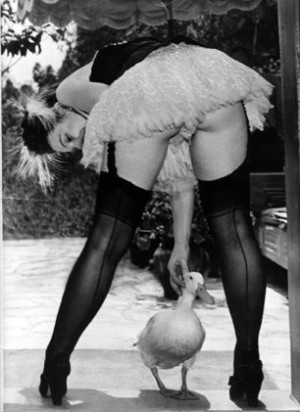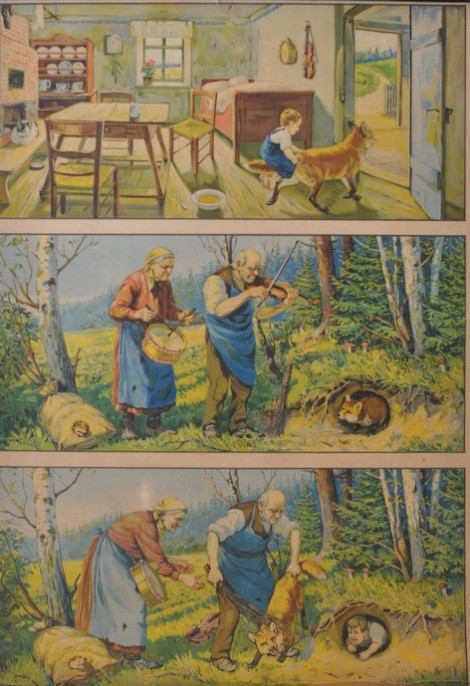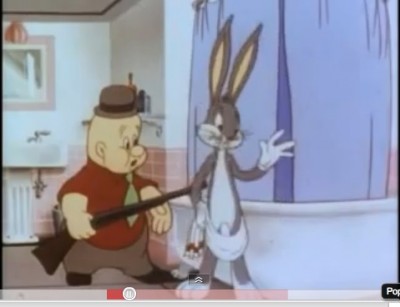Animals
Will Connell

Someone has constructed a Facebook page dedicated to him, which features more great shots like the one here.
Fifteen thousand of his photos are archived here. You have to click thru a couple of links (COLLECTIONS to PERMANENT COLLECTIONS to WILL CONNELL COLLECTION), but then you can search to your heart's content.
Posted By: Paul - Thu May 12, 2011 -
Comments (2)
Category: Animals, Movies, Photography and Photographers, Avant Garde, Sex Symbols, 1940s
Monkey Song
More about Clarence Williams here.
Posted By: Paul - Thu Apr 21, 2011 -
Comments (1)
Category: Animals, Humor, Music, 1930s
Blood Work
Posted By: Paul - Thu Apr 07, 2011 -
Comments (2)
Category: Animals, Mad Scientists, Evil Geniuses, Insane Villains, Medicine, Books
What Does A Wombat Sound Like?
Cranky Wombat from Better Buddies on Vimeo.
Now aren't you sorry you asked?
Posted By: Paul - Tue Apr 05, 2011 -
Comments (5)
Category: Animals, Annoying Things, Noises and Other Public Disturbances of the Peace, Australia
The Fox Catcher

1) A fox comes to a house and steals away a child.
2) The parents track down the fox to his lair and lure him out with drum and violin music.
3) The fox is beaten and/or killed, and the tearful child is saved.
I thought I knew a lot of fairytales, but this one escapes me!
Posted By: Paul - Sun Mar 27, 2011 -
Comments (6)
Category: Animals, Art, Myths and Fairytales, Reader Recommendation
Rabbit Love
I'm not certain that the precise English phrases directed to Mr. Bunny are well understood.
Is it only me, or is all this bunny-stroking oddly erotic?
Posted By: Paul - Fri Mar 11, 2011 -
Comments (4)
Category: Animals, Hobbies and DIY, Video
Bugs Bunny’s Member

Posted By: Paul - Sat Feb 26, 2011 -
Comments (8)
Category: Animals, Cartoons, 1940s, Genitals
Santa Hates PETA
Posted By: Paul - Sat Jan 22, 2011 -
Comments (19)
Category: Animals, Business, Advertising, Products, Holidays, 1980s
Weird Shorts – 4

That’s not to say that our massive consumption doesn’t have it’s upside, As Vangelis Kapatos of Manhattan discovered when he attempted suicide by jumping from his ninth floor flat, only to survive when his fall was broken by a pile of uncollected garbage. Mr. Kapatos’ timing, from his perspective, couldn’t have been worse, the unusually large garbage pile was due to collections being suspended because of snow. They were due to resume the day after his impromptu dumpster dive (Today Online).
Mind you, we’re not the only animals prone to excess. After finding the bodies of dozens of starlings near the city of Constanta in Romania, locals were concerned that the cause might be bird flu, instead post-mortems of the birds have revealed that they in fact died of alcohol poisoning, having ‘drunk’ themselves to death on the discarded leftovers of the local winemaking industry. A least they died happy (BBC News).
Better than dying happy, though, is living happy, and the secret of that, says the UK’s Office for National Statistics, is having a job. But it’s not the pay but the job security that counts, say the government statisticians, which ironically are facing staff cuts themselves due to the economic downturn. Other key happiness factors, according to the preliminary report, are good personal health and a decent family life. What will we do without these people (Telegraph)?
More in extended >>
Posted By: Dumbfounded - Thu Jan 13, 2011 -
Comments (4)
Category: Animals, Dinosaurs and Other Extinct Creatures, Armageddon and Apocalypses, Babies, Crime, Death, Human Marvels, Inebriation and Intoxicants, Religion, Sexuality, Weird Names, Body Fluids, Perfume and Cologne and Other Scents
Another Helping of Food Related Weirdness – 7

Meanwhile, here is someone who is taking the chocolate maker’s art way too literally. Jean Zaun of Fredericksburg in Pennsylvania uses a mixture of dark and white chocolate, food colouring and confectioner’s glaze to recreate famous works of art, including the frames, in a deliciously edible form. Her subjects have included the works of Van Gogh, Munch and Da Vinci, as well as a portrait of Ozzy Osborne commissioned by his wife. While the chocolate artworks are edible, Zaun believes they should be souvenirs rather than snacks. “They are meant to be consumed by the eye, not the stomach.” Zaun Explained (Daily Mail).
And the misuse of materials won’t stop there, at least not if Dr. Peter Eisner of the Fraunhofer Institute gets his way. Concerned that meat consumption is both unhealthy and bad for the environment, Dr. Eisner has started looking for ways to supplement or replace animal products with vegetable equivalents. His first success is a milk substitute derived from lupins that can even be used to make cheese, meanwhile co-worker Daniela Sussmann has extracted a protein from the seeds gives low-fat sausages more of the sensation of their unadulterated competition. Eisner reckons that our ever growing appetite for meat could one day be disastrous, arguing that the resources needed to produce 1 kilo of meat could instead yield 80 to 100 kilos of fruit or vegetables (Softpedia).
More in extended >>
Posted By: Dumbfounded - Mon Jan 10, 2011 -
Comments (7)
Category: Agriculture, Animals, Farming, Art, Food, Bacon, Candy, Junk Food, Nutrition, Vegetables

| Who We Are |
|---|
| Alex Boese Alex is the creator and curator of the Museum of Hoaxes. He's also the author of various weird, non-fiction, science-themed books such as Elephants on Acid and Psychedelic Apes. Paul Di Filippo Paul has been paid to put weird ideas into fictional form for over thirty years, in his career as a noted science fiction writer. He has recently begun blogging on many curious topics with three fellow writers at The Inferior 4+1. Contact Us |




